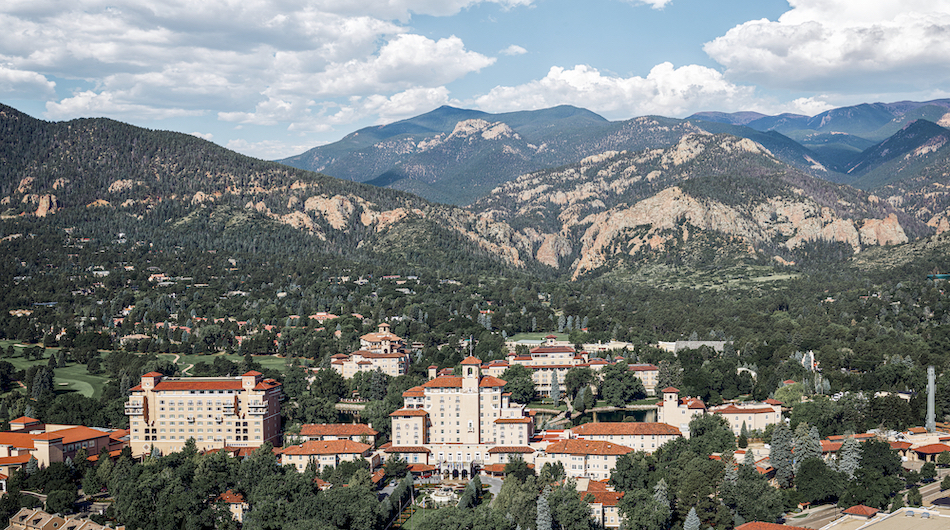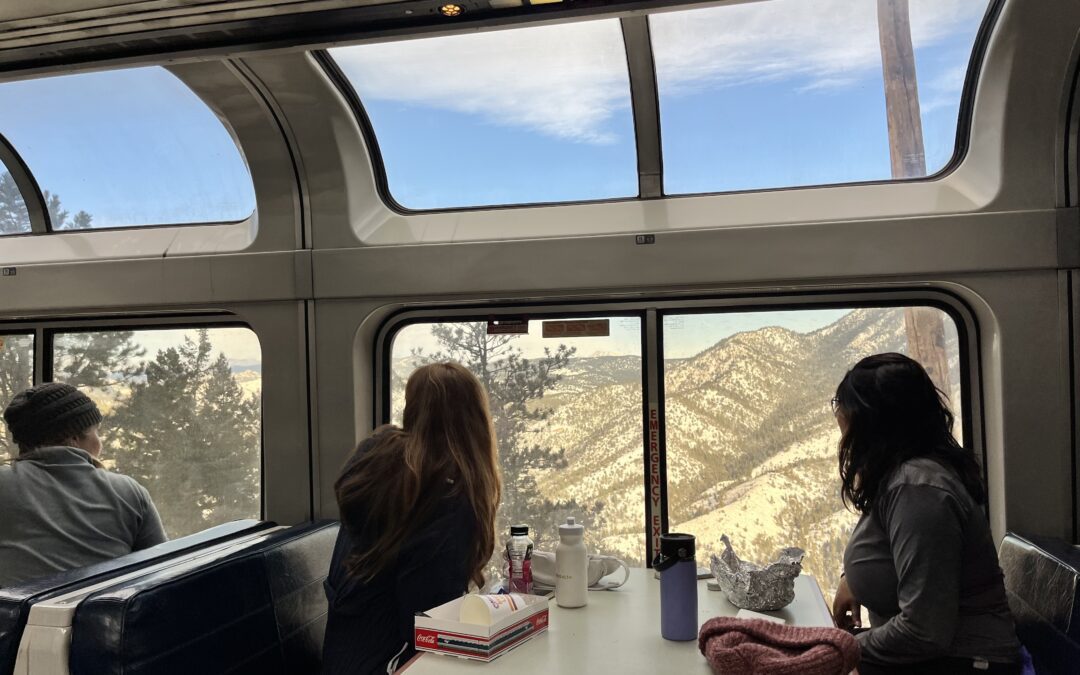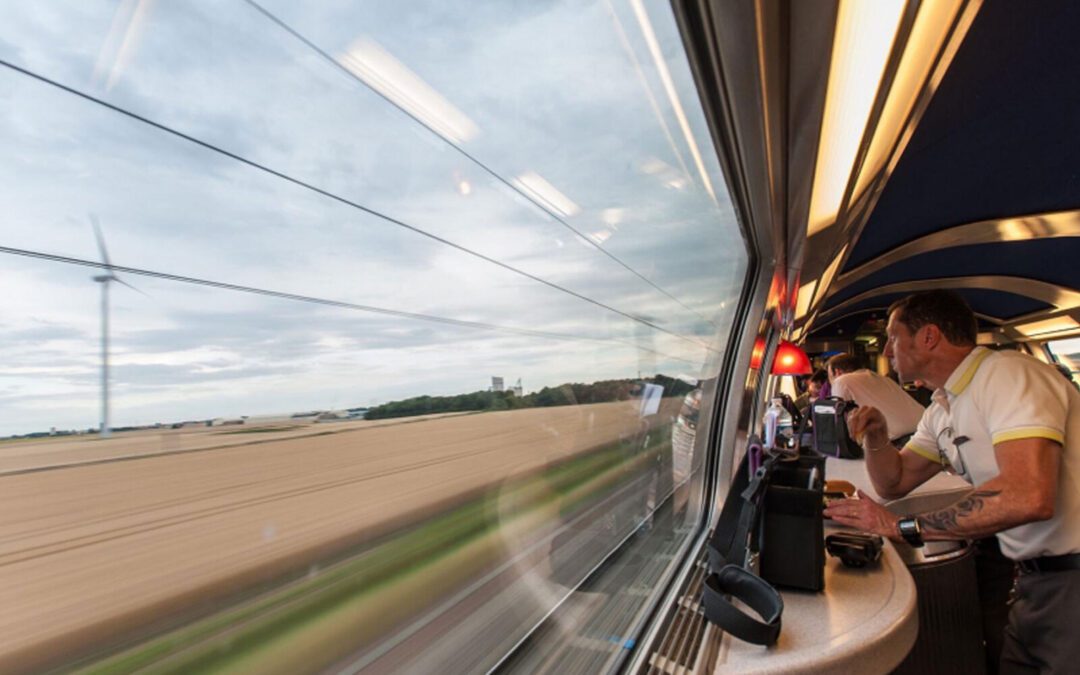Big Changes in Texas and New York This week, US Transportation Secretary Sean Duffy announced major shifts in direction for two important projects. As advocates for quality trains, we need to speak up for the changes we want to see. On Tuesday, Sec. Duffy announced...
As momentum builds for a passenger-rail line in Colorado’s Front Range, will high-speed rail get a fair hearing?
After more than a decade of studying the potential for passenger-rail service in the Front Range Corridor, Colorado is quickly approaching a crossroads. Hard decisions will have to be made—by planners, agencies, and voters—about what they want the line to be.
The Front Range Corridor runs for roughly 200 miles along the eastern foothills of the Rocky Mountains—south to north from Pueblo (CO) to Cheyenne (WY). It includes the towns and cities that are the core of Colorado’s economic and educational infrastructure—not only Denver but Boulder, Colorado Springs, and Fort Collins. About 85 percent of the state’s population lives in the Corridor, and the vast majority of its businesses are located there.
Plans for a passenger-rail line in the Front Range gained strong momentum in June, when Colorado Gov. Jared Polis signed legislation creating a board to oversee its planning. The next step is for the board, which begins meeting in the spring of 2022, to commission detailed service and viability studies. The board will build on the work of the Southwest Chief and Front Range Passenger Rail Commission, which was initiated in 2017.
In January, the Commission summed up its four years of work and its long-range vision for the line, based on the findings of prior studies. The goals it set forth included dedicated, double tracks; 24 weekday round trips (18 on weekends); nine stations; and trains running at up to 110 mph. The high end of the cost estimate for the line was $14.2 billion.
Amtrak’s interest
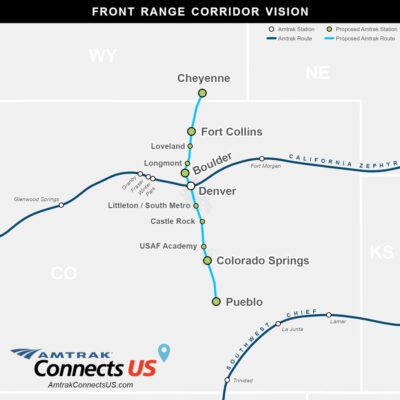 Lately, Amtrak is also expressing strong interest in adding a route in the Front Range Corridor. Amtrak’s CEO, Stephen Gardner, has singled out the route as especially promising. The growth in cities like Atlanta and Denver “has been massive,” Gardner told a news show recently. “These are the types of cities that we think Amtrak can make a big difference in.”
Lately, Amtrak is also expressing strong interest in adding a route in the Front Range Corridor. Amtrak’s CEO, Stephen Gardner, has singled out the route as especially promising. The growth in cities like Atlanta and Denver “has been massive,” Gardner told a news show recently. “These are the types of cities that we think Amtrak can make a big difference in.”
Colorado’s population is projected to grow by about half—to 7.8 million people—by 2045. In the Front Range specifically, the population will grow from nearly 5 million people to 6.6 million. Without substantial interventions, that growth will lead to a doubling of travel times for vehicles in the next two decades.
Amtrak’s “2035 Vision,” released earlier this year, lays out the goal of serving 160 more new communities over the next 15 years. It also aims to increase its overall ridership by 20 million by 2035. An August article in the Denver Postcited Amtrak’s Hiawatha line—running from Milwaukee to Chicago—as a model for what the Front Range line could be. It noted that the trip takes less than 90 minutes and is often faster than driving.
Think bigger and bolder
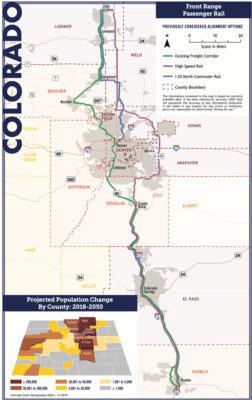 There is a huge gap, however, between Amtrak’s plans and the long-range vision articulated for the route by the Commission. Initially, at least, Amtrak’s would run only three daily round trips.
There is a huge gap, however, between Amtrak’s plans and the long-range vision articulated for the route by the Commission. Initially, at least, Amtrak’s would run only three daily round trips.
As the Front Range Passenger Rail board considers the options over the coming years, HSR advocates must keep a spotlight on the Commission’s stated vision of bringing fast, frequent trains to the Corridor.
That vision is very achievable. A 2010 study commissioned by the Rocky Mountain Rail Authority found that a high-speed line in the Corridor was not only feasible but would offer “a more reliable, enjoyable and convenient way for tourists from all over the globe to get to some of the most important and popular recreational resort destinations in North America and the world.”
Unfortunately, high-speed rail is not playing a significant role in recent discussions of the Corridor’s future. This is a mistake. As a Denver Post writer, Andy Bosselman noted in an essay last year, the Front Range line as envisioned in recent proposals—and in Amtrak’s vision—falls well short of being transformative. “Suppose Colorado wants a rail system that will attract enough riders to reduce carbon emissions and traffic congestion significantly,” Bosselman wrote. “In that case, its leaders must find some courage and set this project on a new track.”
Planners should look at projects like Brightline Florida, which launched with hourly service. Frequent departures are important to making sure these projects are truly useful to passengers.
As an emerging economic powerhouse in a region with strong tourism and tech industries, Colorado is competing with states who are already looking at high-speed rail. The stakes are too high to let limited ambitions—and blurred vision—slow down its progress.
The Latest from HSRA
Our Latest Blog Posts
Check out the latest news, updates, and high speed rail insights from our blog!

Get Involved
Tell the United States Congress: It’s time to reconnect the country with high-speed and regional rail!
